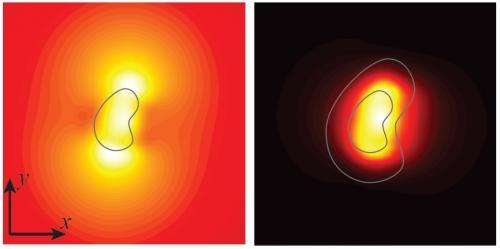Left: Arbitrary shaped nanoscale glass core denoted in black. The optical fields are not confined to the core resulting in fundamental issues of cross-talk detrimental to photonic circuits. Right: Jahani and Jacob have invented a non-metallic metamaterial cladding which compresses the light and forces it inside the core. Credit: Saman Jahani and Zubin Jacob
The invention of fiber optics revolutionized the way we share information, allowing us to transmit data at volumes and speeds we'd only previously dreamed of.
Now, electrical engineering researchers at the University of Alberta in Edmonton, Alberta, Canada are breaking another barrier, designing nano-optical cables small enough to replace the copper wiring on computer chips.
This could result in radical increases in computing speeds and reduced energy use by electronic devices.
"We're already transmitting data from continent to continent using fiber optics, but the killer application is using this inside chips for interconnects—that is the Holy Grail," says Zubin Jacob, an electrical engineering professor leading the research. "What we've done is come up with a fundamentally new way of confining light to the nano scale."
At present, the diameter of fiber optic cables is limited to about 1/1000th of a millimeter. Cables designed by graduate student Saman Jahani and Jacob are 10 times smaller—small enough to replace copper wiring still used on computer chips. (Put into perspective, a dime is about 1 mm thick.)
Jahani and Jacob have invented a new, non-metallic metamaterial that enables them to "compress" and contain light waves in smaller cables without creating heat, slowing the signal or losing data. Their findings will be published in Optica (Aug. 20), The Optical Society's (OSA) new high-impact photonics journal.
More information: The article is available online.
Group's website: www.ece.ualberta.ca/~zjacob
Provided by University of Alberta























